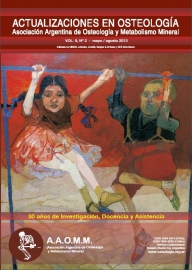Disminución del riesgo de mortalidad en pacientes tratados con bifosfonatos luego de una fractura de cadera por osteoporosis
Autores: Maria Diehl, Andrea Beratarrechea, Natalia Pace, Javier Saimovici, Adriana Trossero, Gastón Perman, Luisa Plantalech
Resumen
El porcentaje de pacientes que recibe tratamiento para osteoporosis luego de una fractura de cadera (FC) es menor a 30%. El tratamiento con bifosfonatos (BF) luego del evento se ha relacionado a disminución del riesgo de mortalidad. Se analizaron las tasas de mortalidad y de tratamiento para osteoporosis luego del inicio de un programa de tratamiento supervisado y se evaluaron los factores de riesgo de mortalidad en pacientes con FC. Se consideraron dos cohortes: histórica (CH) como control e intervención (CI) luego de la implementación de un programa para facilitar el tratamiento con calcio, vitamina D y BF. Se evaluaron la mortalidad y los factores de riesgo mediante los métodos de Kaplan-Meier, Breslow-Gehan y el modelo de Cox. Se incluyeron 252 pacientes en CH (2005-2006) y en CI (2008-2009), de edad x: 79,5 ±8,1 y 81,5 ±7,2 años (p 0,040) respectivamente. El 44% de la CI aceptó participar del programa (CIP). La proporción de pacientes que recibieron BF posterior a la FC aumentó a 54,8% en la CI comparado con 38.5 % de CH (p<0,001). La sobrevida a 30 meses fue mayor en la CIP: 94,2% (87,5-97,3) vs 78,7% (69,0-85,7) en la CI que no participaron y 81,4% (75,7-85,9) en la CH (p <0,006). Los pacientes de ambas cohortes que recibieron BF luego de la FC, presentaron una mayor sobrevida 88,6% (83,4-92,3) en comparación con 79,6% (43,7-84,3) de los no tratados (p: 0.008). Las variables asociadas a mayor mortalidad fueron la edad, diabetes y demencia. El tratamiento con BF luego de la FC fue un factor protector (HR: 0,20 IC: 0,09-0,41 p <0,001). El tratamiento con BF se asoció con reducción del riesgo de mortalidad luego de la FC. Consideramos necesario desarrollar estrategias que faciliten el acceso al tratamiento para osteoporosis luego de una FC.
Palabras clave: Fractura de cadera, bifosfonatos, prevención secundaria, mortalidad, osteoporosis.






